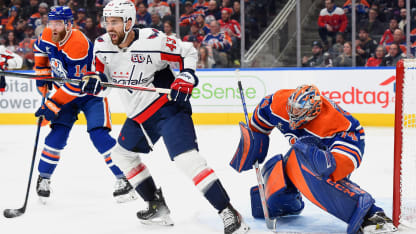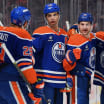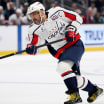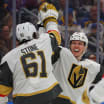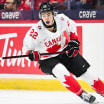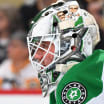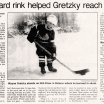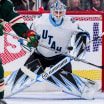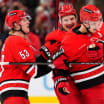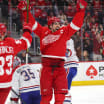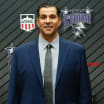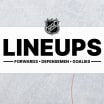VANCOUVER -- One of the hardest adjustments for goalies coming into the NHL is dealing with traffic and learning to find and manage sightlines around it.
It’s a process that is often reduced to “just find any way to see the puck” through all the bodies in front of the net, but it’s more technical. Team systems are designed to ensure defenders are on the same page as their goalie and helping, rather than hindering, efforts to see a shot when it is taken.
“When I played my first NHL game, it was wildly noticeable how much more traffic there is, how much bigger guys are, how much better they are at getting in front of the goalie's eyes,” Edmonton Oilers goalie Stuart Skinner said. “It’s their job to take away your eyes, so they're really good at it and you really notice it at this level.
“That was one of my biggest things I had to work on is traffic management when I first got into the League, just because I felt like I couldn't find the puck ever. Now, I'm getting better at it.”
It's been a long process. The 26-year-old is in his third season as the No. 1 with Edmonton.
Unfortunately for goalies, players are also getting better and more deliberate in their efforts to disrupt sightlines.
It’s no longer “go to the net.”
Traffic these days comes in several forms, each of which must be managed by a goalie. There are layered screens with one player in tight and another higher in the zone, and flash screens, where players skate in front of the goalie, affecting sightlines while a shot is being taken.
Explaining the complexity is difficult, and it can be hard for fans to see how difficult it is for goalies to see the puck, especially watching with traditional broadcast camera angles from the side of the arena.
“There's a lot of things that only as a goalie you can really understand and in the NHL now, I feel like there's always traffic in front of the net,” said Ukko-Pekka Luukkonen, who is in his third full season with the Buffalo Sabres. “There are more moving screens. There are more moving parts. It's not like somebody's just parked in front of you all the time. There's a lot more flash screens, almost every 3-on-2 somebody is driving the net and trying to flash screen you, so it's a big part of the game and I feel like offensive players know the importance of it too.”
One player planted in front of the goalie is rarely as effective as it once was, but other types of screens are taking its place.
“I feel like the easiest screen to play is the one where you have a guy standing in front of you, because you can pick your side,” said former New York Rangers goalie Steve Valiquette, who founded Clear Sight Analytics, a company that quantifies shot quality, and tracks and measures six different types of screen-scoring chances.
“I'm a pretty tall guy (6-foot-5), so I can just look over a lot of the moving screens, but when the screen is a couple of feet away from you, it's moving, the shooters know how to read the screen too now, so they will wait until the screen moved away from you and you're looking from the wrong side of the screen. I feel like players have figured it out, too.”
That includes how to manipulate the general rules most NHL goalies and teams follow for managing a single screen. When Luukonen talked about “picking a side” to look around a screen with a shooting threat on the wing or flank, most teams ask their goalies to hold a sightline on the short side. It’s a choice rooted in probability and geometry.
The geometry is simple: If you draw a line from the puck to each post, the line to the near post is shorter. In other words, the puck gets to the net faster on the short side, so hedging to that side around a screen allows the goalie to fill the space the puck can go in fastest. They have more time to react to a shot to the far side, the other side of that screening forward.
The probability part involves the increased likelihood of a shot into the middle of the ice hitting someone, which is why most teams ask shot-blocking forwards or flexing defensemen to fill that far-side lane with the goalie on the short side.
“You always want to take the short side away when you can,” Matt Murray of the Toronto Maple Leafs said while breaking down video of a screen save, adding the handedness of the shooter also matters. “The easier shot is short side because there’s a lot more stuff in the way on the far side. I’m not saying every time, but there’s more (players) on the far side so the percentages are he’s going to want to shoot it short side and the guy in front more often than not holds on the far side.”
Of course, teams have begun figuring out how to exploit those natural tendencies, especially with more time and space to set plays on a power play, including using the goalie’s own defensemen to add layers and increase the complexity.
Screening forwards will drift into the goalie’s preferred short-side lane, forcing a switch to the middle and surrendering vision on the puck when moving behind the screen as a shot is taken.
When goalies started to figure that out, switching earlier under the assumption a shooter wouldn’t aim at a player on his team who was screening short side, some teams began working to do just that and having the forward jump out of that space at the last second, further complicating an already difficult cat-and-mouse game.
“Some of the good screeners in the League will try to time that screen so as the shot is being released they almost switch from the weak side to try and take away more of your line of sight,” Murray said. “At the end of the day, what you are looking for is the most possible time with your eye on the puck.”
Creating that time has never been harder for NHL goalies.
It's very, very situational,” Skinner said. “You've just got to find the puck.”
